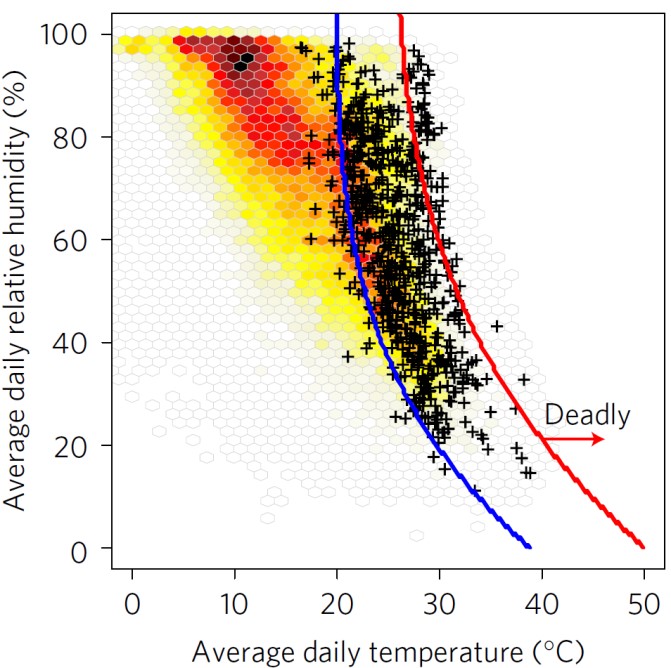Heatwaves pose a considerable concern to human life when their conditions exceed the capacity of the body to expel heat. This causes a life threating situation referred to as hyperthermia. Numerous cases like the 2003 European heatwave, when 70,000 people died in a two-week heatwave, or the 2010 Moscow heatwave, when 10,000 people die in a two month heatwave, are some staggering examples of the risk to life posed by heatwaves. Aside from a handful of other highly cited deadly heat events, little is known about how common killer heatwaves are.
In an exhaustive literature review, a group of researchers at the University of Hawaii Manoa collected data on 783 cases, from 164 cities in 36 countries, where people have died during heatwaves. Their analysis of the climatic conditions on those cities at those times revealed a common threshold of temperature and humidity beyond which conditions turned deadly (Blue line in Figure below). To increase the degree of confidence, the researchers calculated a 95% confidence probability around such a threshold (red line in Figure below), which yielded a threshold beyond which only deadly heatwaves have been reported.
This web-app counts the number of days in a year when conditions of temperature and humidity surpass that threshold and thus pose a risk of death (i.e., the number of deadly days). The map and time plots are based on the average of 20 Earth System Models developed for the recent Coupled Model Intercomparison Project Phase 5, under scenarios RCP26, RCP45 and RCP85, which represent a range of conditions from strong reductions of CO2 emissions to business as usual, respectively. The application also allows visualizing the temperature and humidity of any place for a given year in comparison to the threshold; that graph is based in the projections of one Earth System Model only.

Temperature and humidity during prior lethal heat events (black crosses) and during periods of equal duration from the same cities but from randomly selected dates (color gradient, figure from Mora et al 2017). Blue line is the threshold that best separates times in the studied cities when conditions where lethal or not. The red-arrow is a threshold that yielded a 100% certainty on heatwaves being lethal, when it was surpassed.
For more information please review Global risk of deadly heat (2017) by Mora et al from the University of Hawai'i's Department of Geography.
This application was designed and developed by Esri's Applications Prototype Lab in Redlands, California. For your convenience, we have prepared animated heawave videos for the following experiments: rcp26, rcp45 and rcp85. Source code for this application is available here.